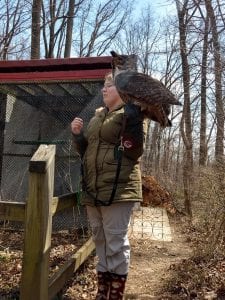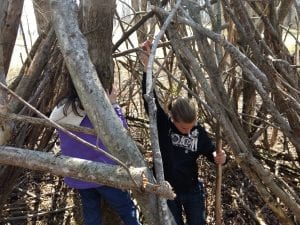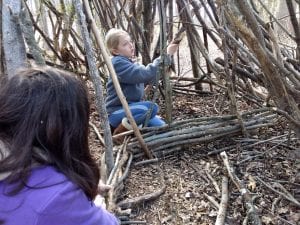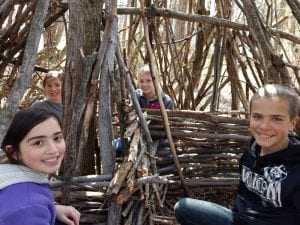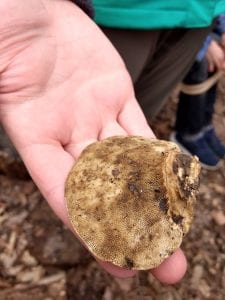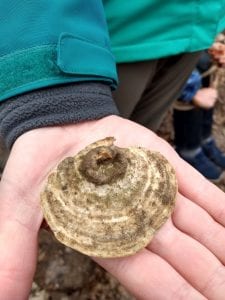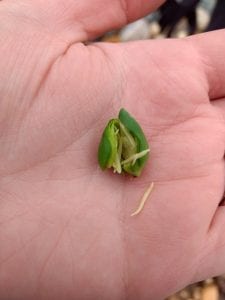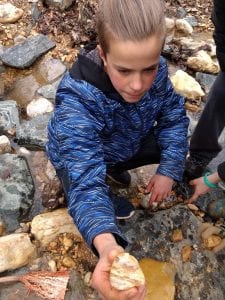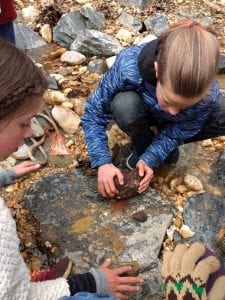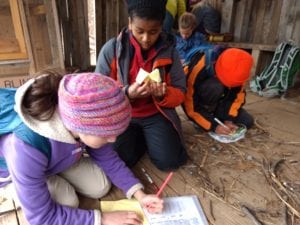4/10/18
Mid-Semester Campfire Celebration
Today marked the (almost) half way point for our homeschool semester! We started the day by meeting one of Irvine’s newest animal ambassadors, the Great Horned Owl. Jenna, our animal care specialist, showed us the owl and we learned a lot about the owl and falconry! Over the last few weeks we have been learning about birds and how to sketch them. We also did learn more about owls and their amazing adaptations that have inspired cool technologies (our biomimicry connection, which you can read more about in last week’s blog). So, while we learned more about Irvine’s Great Horned Owl, we sketched her too! It was a new challenge trying to draw a real bird, since she wouldn’t stay completely still but it was also a great way to learn how to sketch a living bird! Some of us sketched really fast while she stayed in one position while others sketched slower and waited for her to return to her previous position before continuing to draw. Sketching while learning is a great way to not only remember what you are learning and seeing but it also gives you a different connection to your subject. Sketching helps by allowing you to see things you may have not noticed before. It also helps you focus and stay more engaged in the activity. We will be using sketching more as the weeks go by! (In fact, we use it in the next week, which you can read more about below!).
After spending some time with the Great Horned Owl, we continued down the trail, enjoyed a quick snack and then explored a small shelter in the woods. We worked together to repair some of the walls, add more branches and we even wove an intricate wall made out of sticks inside to make it feel more homey. At 3 o’clock we joined the two other homeschool groups and their families and ours for a celebration campfire down at the education barn. We learned some basic fire safety rules before enjoying snacks and s’mores. In the coming weeks we plan to work on the skill of fire building and construct our own individual campfires.
4/17/18
Bursting Buds
Spring has arrived (I think? It was snowing today!) so the trees and other plants are starting to leaf out and bloom! This is a perfect time to explore some of the science behind plant buds, why they open when they do, what’s inside of them and why some plants leaf out before others. These are all concepts we explored today. With snow flurries indicating a chilly day, we braved the cold and headed out to our afternoon gathering spot. Here we went over what the rough schedule was for the day and then jumped straight into buds. Thinking and talking about buds seemed to make more sense on a sunny day with the birds singing in the woods, but we would have to make do with the weather we had! We started by defining what a bud even is? A bud is a plant’s way of preparing for spring. Plants grow buds late in Fall and the bud survives the cold, harsh winter to then open when the conditions are right in spring. But what’s inside? Baby leaves wait to grow and are protected by leaves called scaled leaves. These tougher leaves on the outside protect the delicate, green leaves on the inside.
Looking around the forest we made some observations about the plants around us. Some of them we noticed were almost fully leafed out, which means, they were already covered in green leaves, while others had some leaves near their tops and some had hardly leafed out at all. The trees, like hickories, still had closed buds on their branches, while the spicebush had a variety of leaves and small, yellow flowers, while non-native plants like privot were fully leafed already (in the photo above featuring Piper, Noa and Eva, the plant on the left is privot and the plant on the right is spicebush). We then went over what a non-native plant was versus a native plant and why it mattered. Non-native plants have a growing advantage. They usually leaf out first, blocking the sun to native plants so they can’t grow. They also grow faster because their leaves are out sooner and James also brought up that they will steal nutrients from nearby plants, possibly affecting their growth. All of these are great observations and concepts to be aware of in our forest here at Irvine. We decided to examine this idea closer by doing a sketch in our journals. We hiked down the trail a short distance to a different fairy log circle in the woods and pulled out our sketch books. Before we got sketching, Lev helped me cut open a hickory bud to take a look inside. The bud had already opened slightly (the scaled leaves had already parted to reveal the more delicate leaves underneath) so we weren’t able to see the bud protecting the leaves inside, but we did get to see just how many leaves were folded in that small bud. It also smelled great too!
Our task was to pick a bush or tree and examine its buds. We were to either draw the bud(s) in our journal or write what we saw or both. We all picked a spot and spent a few minutes examining our plant of choice. Some of drew the plant close up and labeled the individual parts, some of us drew them from a distance and interpreted the plant on a broader scale, while others drew more than one plant and compared and contrasted. Now it was time to warm up. We packed our journals to share later at the Ed Hut and hiked along the Headwaters Looptrail to the stream.
At the stream we explored the plants and noticed skunk cabbage is really growing. We plan to discuss skunk cabbage more next week. We spent most of our time in the part of the stream with the large amount of rocks, looking through the rocks and even painting with them! James, Eva and Jasper discovered the rock painting! We used different types of rocks that dissolved slightly in water and then rubbed them on a much larger rock! One of the rocks likely had clay in it and the other iron. After spending a bit of time at the stream, we hiked to the Ed Hut where we planned to do a journal share of the plant we sketched in the forest and work on our nature fortune tellers that was meant to be a nature trivia game!
At the Ed Hut we started making our fortune tellers. Our biomimicry connection for today was the science of how plants can fit such a large amount of material (leaves) into such a small place (bud). An example in a book called “Biomimicry: Inventions Inspired by Nature” by Dora Lee, explains how the Hornbeam leaf is disproportionally large for the size of the bud it fits in. Scientists are studying this leaf packed into a tight space to apply it to solar panels for space! Even though the leaves are small, scientists have studied how these bud packages fold the leaves inside them, so to speak. This folding is like nature’s origami. We ran out of time but we planned to do some origami flowers. We’ll be saving these for the week of May 8th. At the Ed Hut we folded our fortune tellers and then our task was to think of some nature facts that we could write inside. These nature facts we had to know the answer to so we got to pick our own questions (facts). We then started quizzing each other, it was a lot of fun and we all learned some cool stuff! Like, why can’t an opossum get rabies? Because their body temperature is relatively low for a mammal and the rabies virus can’t survive in their bodies. Cool! By the time we were finished with our nature fortune tellers it was snowing again (it’s the middle of April right?) and it was time to head back to Irvine!
Pictured below: A shelf fungus already detached (both sides), a tulip poplar bud we found at the stream and us working on rock painting and our nature fortune tellers.

